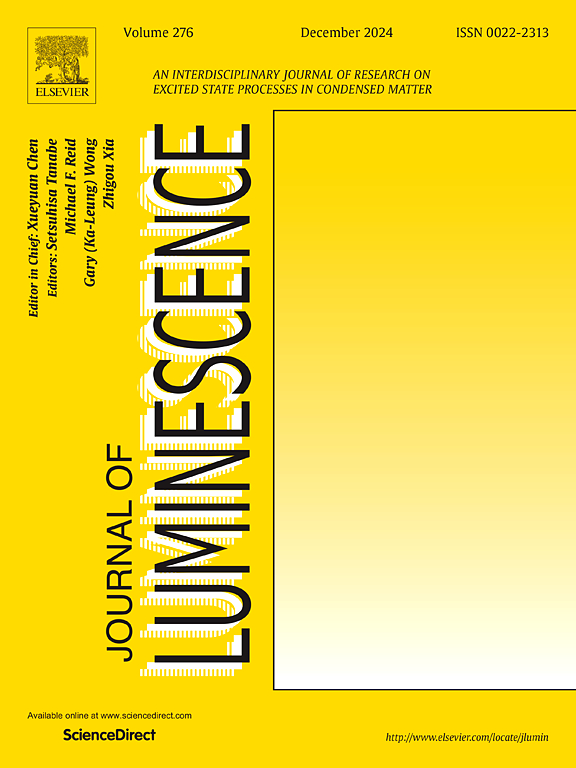一种具有高热稳定性的nir - nir Ca2ZrSi4O12:Yb3+荧光粉防伪纤维
IF 3.3
3区 物理与天体物理
Q2 OPTICS
引用次数: 0
摘要
近红外(NIR)激发到近红外发射(NIR-to-NIR)由于其安全特性,可以应用于各种领域,特别是防伪技术。在本研究中,通过传统的固相反应合成了Yb3+掺杂的Ca2ZrSi4O12作为一种新型的nir - nir荧光粉。合成的Ca2ZrSi4O12:Yb3+荧光粉具有单斜晶型结构,为初级相,平均粒径为5 ~ 10 μm。由于Yb3+离子的电荷转移和2F7/2→2F5/2跃迁,在紫外和红外区显示出三个激发带。915 nm近红外激发下的发射光谱显示,在950 ~ 1050 nm范围内有较强的近红外发射带,对应于Yb3+离子的2F5/2→2F7/2跃迁。Ca2ZrSi4O12:Yb3+荧光粉表现出优异的热稳定性,在375°C时保持其初始发射强度的84.5%,并且在随后的冷却中表现出最小的热降解。最后,制备了以Ca2ZrSi4O12:Yb3+荧光粉为添加剂的防伪母粒,并对其近红外发射特性进行了验证。因此,Ca2ZrSi4O12:Yb3+荧光粉有望用于复杂的防伪技术。本文章由计算机程序翻译,如有差异,请以英文原文为准。
A NIR-to-NIR Ca2ZrSi4O12:Yb3+ phosphor security fiber with high thermal stability for anti-counterfeiting applications
Near-infrared (NIR) excitation to NIR emission (NIR-to-NIR) can be applied in diverse fields, specifically anti-counterfeiting technologies, owing to its security feature. In this study, Yb3+-doped Ca2ZrSi4O12 was synthesized as a novel NIR-to-NIR phosphor via a conventional solid-state reaction. The synthesized Ca2ZrSi4O12:Yb3+ phosphor exhibited a monoclinic structure, as the primary phase, and an angular morphology with an average particle size of 5–10 μm. It showed three excitation bands in the ultraviolet and infrared regions due to the charge-transfer and 2F7/2 → 2F5/2 transitions of the Yb3+ ions. The emission spectra obtained under 915 nm NIR excitation displayed a strong NIR emission band in the 950–1050 nm range, which correspond to the 2F5/2 → 2F7/2 transition of Yb3+ ions. The Ca2ZrSi4O12:Yb3+ phosphor exhibited excellent thermal stability, maintaining 84.5 % of its initial emission intensity at 375 °C, and showed minimal thermal degradation upon subsequent cooling. Finally, a masterbatch comprising the Ca2ZrSi4O12:Yb3+ phosphor as an additive was manufactured for anti-counterfeiting applications, and its NIR-to-NIR emission characteristics were confirmed. Thus, Ca2ZrSi4O12:Yb3+ phosphors are promising for sophisticated anticounterfeiting technologies.
求助全文
通过发布文献求助,成功后即可免费获取论文全文。
去求助
来源期刊

Journal of Luminescence
物理-光学
CiteScore
6.70
自引率
13.90%
发文量
850
审稿时长
3.8 months
期刊介绍:
The purpose of the Journal of Luminescence is to provide a means of communication between scientists in different disciplines who share a common interest in the electronic excited states of molecular, ionic and covalent systems, whether crystalline, amorphous, or liquid.
We invite original papers and reviews on such subjects as: exciton and polariton dynamics, dynamics of localized excited states, energy and charge transport in ordered and disordered systems, radiative and non-radiative recombination, relaxation processes, vibronic interactions in electronic excited states, photochemistry in condensed systems, excited state resonance, double resonance, spin dynamics, selective excitation spectroscopy, hole burning, coherent processes in excited states, (e.g. coherent optical transients, photon echoes, transient gratings), multiphoton processes, optical bistability, photochromism, and new techniques for the study of excited states. This list is not intended to be exhaustive. Papers in the traditional areas of optical spectroscopy (absorption, MCD, luminescence, Raman scattering) are welcome. Papers on applications (phosphors, scintillators, electro- and cathodo-luminescence, radiography, bioimaging, solar energy, energy conversion, etc.) are also welcome if they present results of scientific, rather than only technological interest. However, papers containing purely theoretical results, not related to phenomena in the excited states, as well as papers using luminescence spectroscopy to perform routine analytical chemistry or biochemistry procedures, are outside the scope of the journal. Some exceptions will be possible at the discretion of the editors.
 求助内容:
求助内容: 应助结果提醒方式:
应助结果提醒方式:


